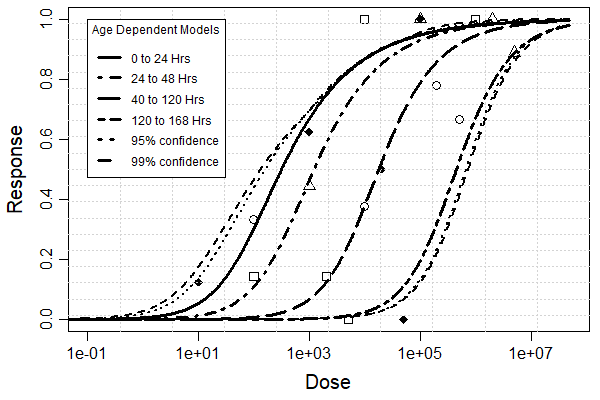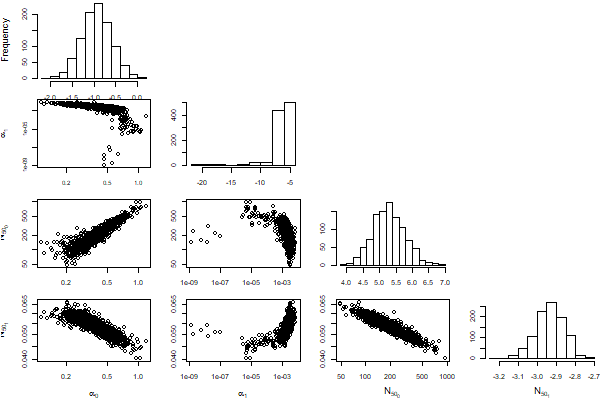General Overview
Variola major (V. major) is the causative agent of smallpox. Smallpox is a disease within the poxvirus group, which causes diseases with similar manifestation and symptoms with very different severities. Chickenpox, a disease with very low mortality associated with childhood is within the poxvirus group as well, however, does not have the severity or lethality of smallpox.
Summary Data
Marshall and Verone (1961) challenged suckling mice with varying doses of V. major intraperitoneally. Four different ages of suckling mice were exposed (10-hour, 35-hour, 85-hour, and 145-hour old mice) and death was the recorded response. The four different experiments are shown in Table 1.
Table 1:
| Experiment |
Age (Hours) |
Dose (PFU) | Number of Mice | Number of Positive Responses | Number of Negative Responses |
| 1 | 10 | 100000 | 9 | 9 | 0 |
| 10 | 10000 | 9 | 9 | 0 | |
| 10 | 1000 | 9 | 4 | 5 | |
| 10 | 100 | 9 | 3 | 6 | |
| 10 | 10 | 8 | 1 | 7 | |
| 2 | 35 | 1000000 | 11 | 11 | 0 |
| 35 | 100000 | 8 | 8 | 0 | |
| 35 | 10000 | 8 | 3 | 5 | |
| 35 | 1000 | 8 | 5 | 3 | |
| 35 | 100 | 7 | 1 | 6 | |
| 3 | 85 | 2000000 | 9 | 9 | 0 |
| 85 | 200000 | 9 | 7 | 2 | |
| 85 | 20000 | 8 | 4 | 4 | |
| 85 | 2000 | 7 | 1 | 6 | |
| 4 | 145 | 5000000 | 9 | 8 | 1 |
| 145 | 500000 | 9 | 6 | 3 | |
| 145 | 50000 | 8 | 0 | 8 | |
| 145 | 5000 | 8 | 0 | 8 |
Weir and Haas (2009) fit the conventional exponential and beta-Poisson models to each individual dataset and a pooled dataset of all ages combined. Neither model provided a good fit to the pooled dataset, and it was determined that age was significantly influencing the dose response relationship. A modification of the exponential and beta-Poisson models was explored to evaluate the influence of incorporating age-dependent parameters. Equation 1 is the age-modification made to the exponential k parameter, such that k* is calculated with k0, k1 and the age of the mouse in hours. Similarly, Equations 2 and 3 and the age-modifications to the approximate beta-Poisson parameters of
Eq. 1
Eq. 2
Eq. 3
The age-dependent models were fit to the pooled datasets (n=18). Incorporating an age dependency improved the accuracy of the beta-Poisson model by 72%, and thus the age dependent beta-Poisson with parameters α0, α1, N500 and N501 is the recommended model for use as shown in Table 2. The modified beta-Poisson models for each age group are shown in Figure 1 and the bootstrapped parameter estimates are shown in Figure 2. More information about methods can be found in Weir & Haas (2009) .
Table 2:

Figure 1: Modified beta Poisson dose-response models for each age group, encapsulated in overall confidence bounds for the modified model.

Figure 2: Comparison of bootstrapped age dependent parameters after 10,000 iterations.